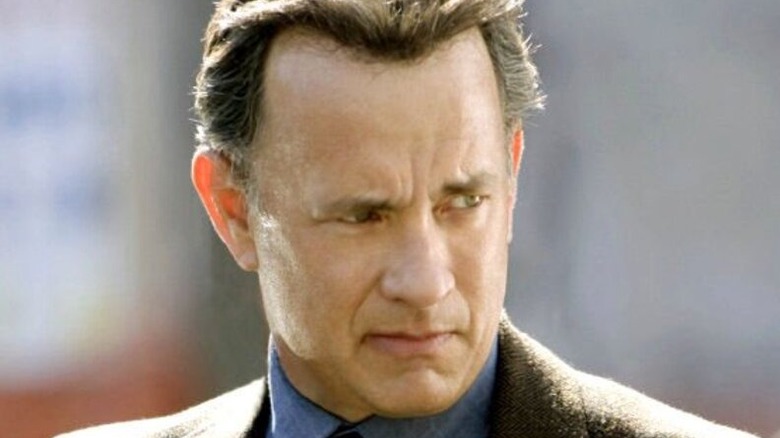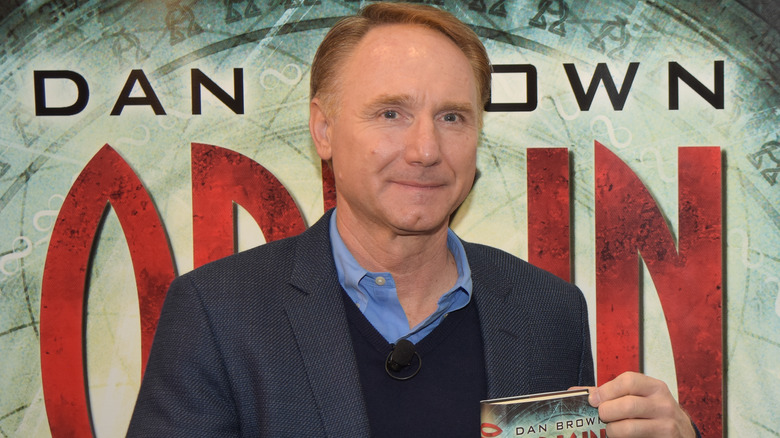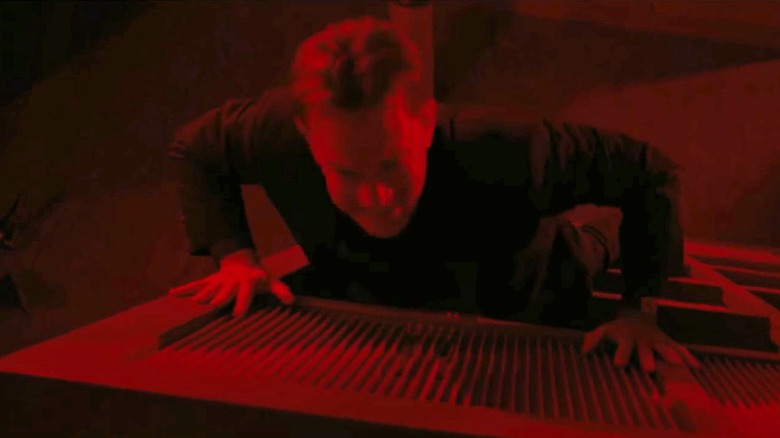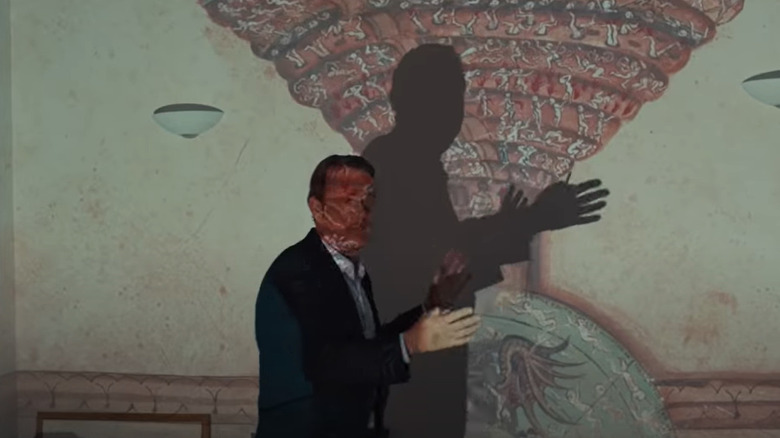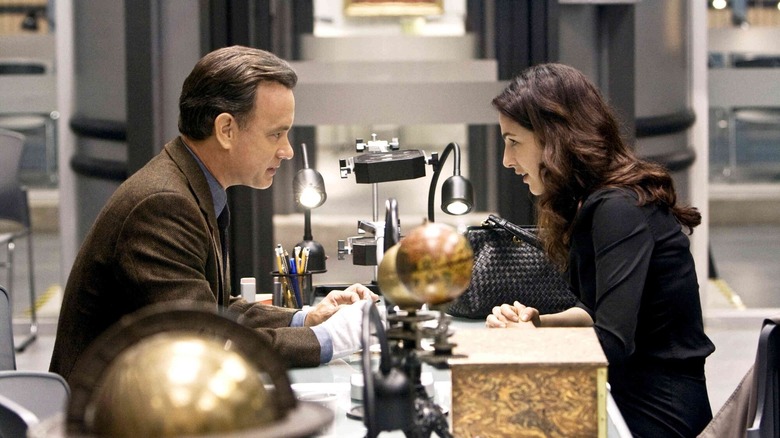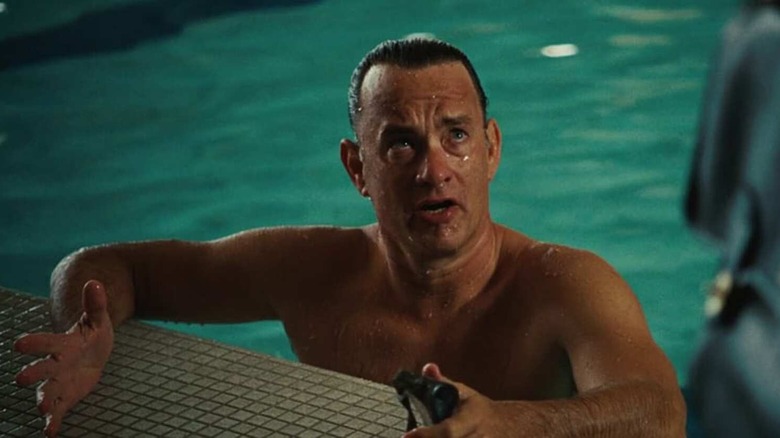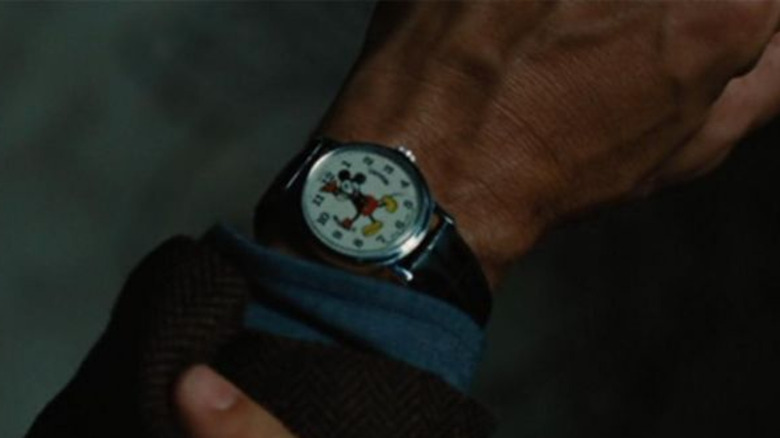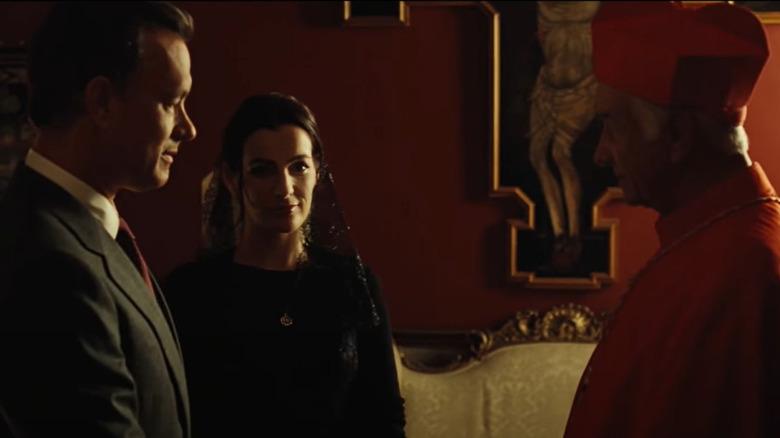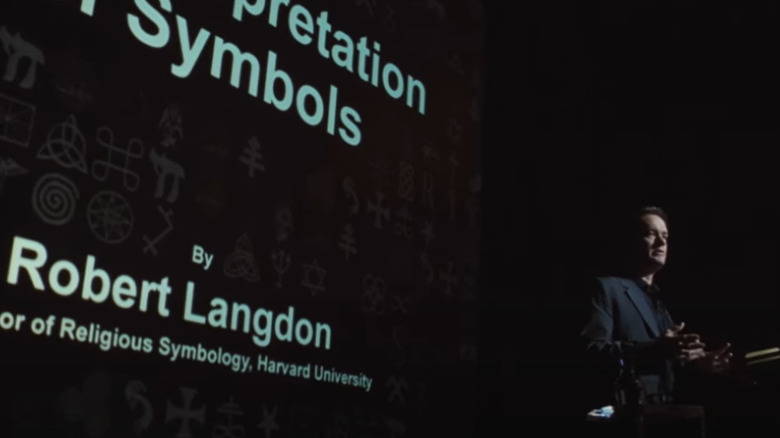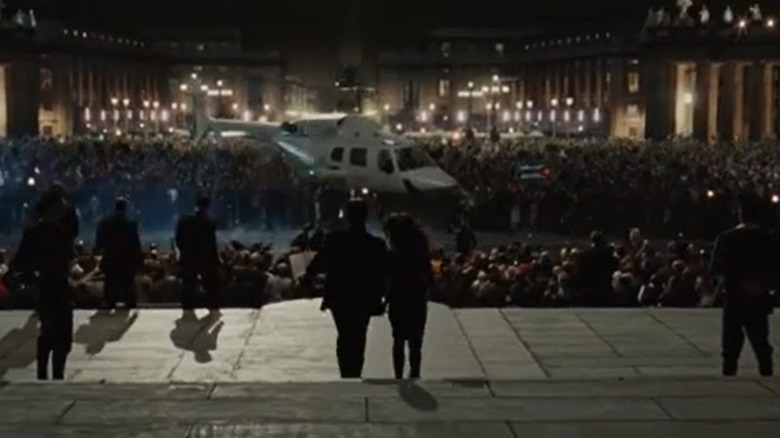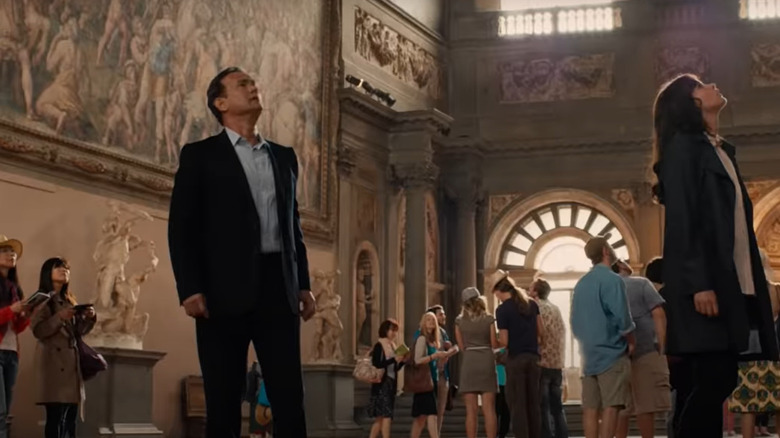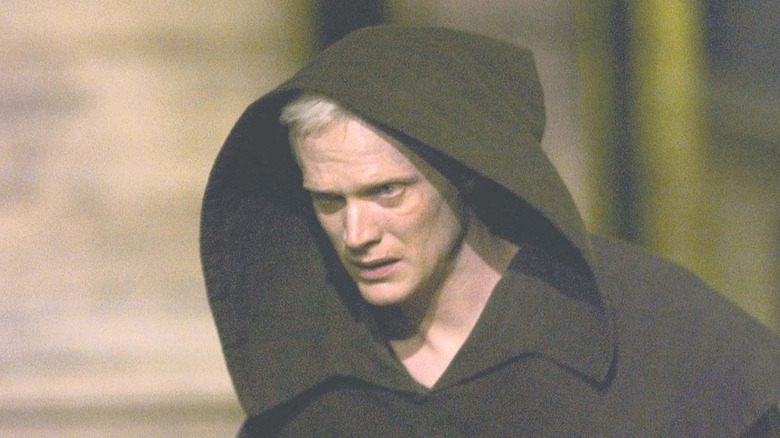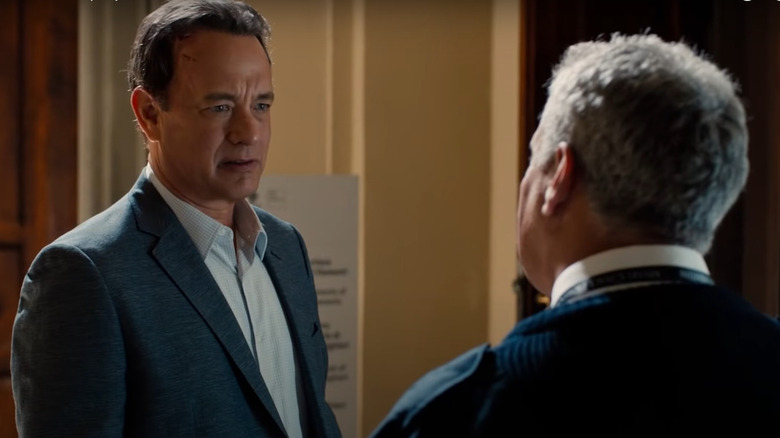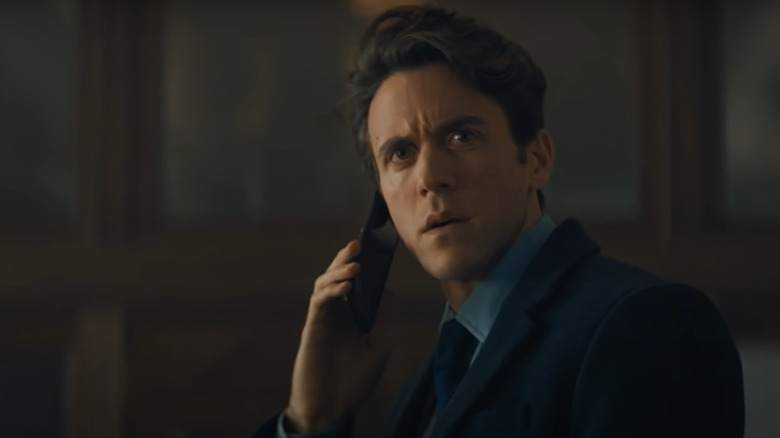The Untold Truth Of Robert Langdon
Adventure fiction is filled with muscular he-men with broad shoulders and deadly fighting skills, who solve problems via kicking and punching. What is less prevalent is the thinking man's action hero, one who solves problems by using his mind rather than fisticuffs. Into that latter category falls Professor Robert Langdon, the central hero of best-selling novelist Dan Brown's series of mystery-thriller novels starting with 2000's "Angels and Demons."
Armed with nothing but his swimmer physique and a frankly preposterous amount of knowledge about the world of symbols and conspiracies, Professor Langdon jumps from one world-threatening event to another and generally manages to save the day. The character exploded into popularity with his second novel, 2003's "The Da Vinci Code," a fast-paced thriller revolving around the present-day bloodline of Jesus Christ.
In the past two decades, Langdon has become one of the most popular heroes in fiction, being compared to a host of similar counterparts from Indiana Jones to Van Helsing. The character has been brought to life on the big screen by Tom Hanks in three movies so far, and will be played by Ashley Zukerman in the upcoming series, "The Lost Symbol." Here are some facts about Langdon's complicated past and present that fans should know.
Real life inspirations
Robert Langdon is far from an average joe. He is insanely smart, extremely well-read, and in excellent physical shape. He is also unfailingly polite and righteous, and believes in using his talents to help humanity. Such a character can be difficult to buy into, but his creator Dan Brown had some excellent real-life precedents to base the character on to make Langdon believable and relatable.
As far as physical appearances go, Langdon resembles Harrison Ford. This was made clear in "The Da Vinci Code," which describes Langdon as "Harrison Ford in Harris tweed." Clearly, Brown had that "Indiana Jones" swagger in mind when coming up with his own treasure-hunting intellectual protagonist. The author has also cited John Langdon, a professor of typography at Drexel University, as a major source of inspiration.
Finally, there was celebrated academic Joseph Campbell, best known to the public for his treatise on pop culture archetypes, "The Hero with a Thousand Faces." In an interview with The New York Times, Brown explained which qualities of Campbell he wanted to imbue Langdon with, stating, "I remember admiring Campbell's matter-of-fact responses and wanting my own character Langdon to project that same respectful understanding when faced with complex spiritual issues."
An insert-self-here creation
Given Robert Langdon's many talents and good nature, and the fact that he constantly impresses the other characters in his novels while managing to sleep with a bevy of beautiful and accomplished women, it can be easy to consider him a "Gary Stu"-type creation, a bit of wish fulfillment on the part of the author by imagining Langdon as a more charismatic version of himself.
While such characters are looked down upon in the fictional world and can more often be found in the realm of fan fiction, author Dan Brown has no problem admitting that Robert Langdon is meant to be a glamorized version of himself. Brown grew up on the campus of Phillips Exeter Academy where his father, Richard G. Brown, taught mathematics. Brown himself had a deep and abiding interest in codes and world history, and taught classes at Beverly Hills Preparatory School while trying to make it as a singer-songwriter and pianist.
Brown's academic interests, plus his familiarity with campus life and the world of codes and puzzles, led him to create Robert Langdon. In an interview with NHPR, Brown admitted that Langdon is "the man I wish I could be," adding "We share an intellectual curiosity and a love of art and symbols but he's much braver than I am, he has a much more interesting life, he's much smarter than I am, and he's just a lot of fun to work with."
Langdon's childhood trauma
Robert Langdon usually comes across as a remarkably well-adjusted person. The man has been involved in cataclysmic, world-ending events on several occasions, but he still goes right back to his regular life of teaching at Harvard and geeking out over the latest art exhibit at the local museum. But like any well-rounded character, Langdon has his own personal demons to deal with from his past.
At the tender age of seven, he fell into a well and was trapped there at night. While he was eventually rescued, the incident left a scar on Langdon's mind. Ever since then, he has suffered from claustrophobia and a general fear of enclosed spaces. In "Angels and Demons," we discover just how much his condition has affected Langdon's life, as the book states, "[Langdon] avoided enclosed sports like racquetball or squash, and he had gladly paid a small fortune for his airy, high-ceilinged Victorian home ... Langdon had often suspected his attraction to the art world as a young boy sprang from his love of museums' wide open spaces."
This fear of closed spaces has come back to haunt Langdon on many occasions over the course of his adventures. Whether uncovering ancient secrets in the Vatican's top secret archive, or being trapped in close quarters with murderous assassins, Langdon is often shown to be wrestling with panicky impulses in relation to claustrophobia that get in the way of plotting an escape.
A fictional job
In the books, Robert Langdon is described as a Harvard University professor of history, art, and "symbology." It's an impressive title. Too bad its a fictional job. There is no such thing as a professor of "symbology" at Harvard.
In the real world, there are other job descriptions for those who study specifics of history through symbols, from "professors of religious iconography," and "professors of cryptography," to regular "art historians." The closest thing to Langdon's job as described in the novels involve the field of "semiotics." In semiotics, language scholars study the ways in which signs and symbols influence the development of languages and communication the world over.
The reason Dan Brown chose to give his most well-known creation a fake job was because it allowed him to repeatedly place Langdon squarely in the middle of world conspiracies as an expert. "I intend to make Robert Langdon my primary character for years to come," Brown has stated to BookBrowse, explaining, "His expertise in symbology and iconography affords him the luxury of virtually endless adventures in exotic locales."
A ladies' man
Professors and similar intellectuals are rarely depicted as objects of passion in fiction. Having multiple love interests is usually seen as the prerogative of men of action like James Bond rather than of geeks and nerds. But Robert Langdon bucks the trend by being an unashamedly smart, geeky guy who has hooked up with an impressive number of gorgeous women who have achieved a lot in their own right.
First there was Vittoria Vetra in "Angels and Demons." Vittoria was a scientist at CERN who was also described as being extremely beautiful and fit. At the end of the novel, she and Langdon engage in some steamy action between the sheets but then we never hear from her again. The only reference we get is a mention in "The Da Vinci Code" that Robert had last seen Vittoria over a year earlier. Then came Sophie Neveu, the secondary protagonist of "The Da Vinci Code" who was hinted to be a literal descendant of Jesus Christ.
Once again it is strongly implied that she and Langdon had a fling, but we never see her again when the latter embarks on his next adventure in "The Lost Symbol." It is also mentioned in "Angels and Demons" that his university students described Langdon's deep, low, baritone voice as "chocolate for the ears." Clearly, the adventurous professor is not hurting for female attention by any measure despite seeming to spend most of his time being swept up in the world of shadowy societies and world conspiracies.
He's nicknamed the Dolphin
Although most of Robert Langdon's day job consists of teaching classes and poring over ancient texts and artwork, he has shown himself to be remarkably gifted at the many kinds of physical exertions that saving the world entail, from jumping out of a helicopter without a parachute to running away from murderous assassins.
It can be difficult to imagine a stodgy old professor embarking on such daring adventures without suffering a heart attack halfway through. That is why Dan Brown is careful to include an explanation for Langdon's physical state in the books. The character is described as being 6 feet tall and over 40 years old. Langdon battles the effects of the march of time on his body by religiously swimming 50 laps a day in the university pool.
Langdon's affinity for water is shown to be an old one, which also earned him the nickname "The Dolphin." In "Angels and Demons," Brown writes "[Langdon's] campus nickname — 'The Dolphin' — was a reference both to his affable nature and his legendary ability to dive into a pool and outmaneuver the entire opposing squad in a water polo match." Tall, smart, and a swimmer's body: No wonder so many ladies are shown to get all hot and bothered over being lectured by Professor Langdon.
Young at heart
Robert Langdon often feels like a character who doesn't belong in his own stories. The worlds created by Dan Brown are full of humanity-ending threats, shadowy societies that employ merciless assassins, and self-important officials who are desperately trying to preserve the status quo.
Langdon, on the other hand, is much more relaxed and ready to joke around, except in life-threatening situations. He is also not afraid to talk about his feelings or confess to emotions considered unmanly in adventure fiction. This childlike attitude actually has roots in Langdon's childhood, and the Mickey Mouse watch he wears at all times to remind himself of the importance of staying open to youthful enthusiasm.
The watch was a gift to Langdon from his parents on his 10th birthday. In "The Da Vinci Code," Dan Brown writes, "Although its juvenile dial often drew odd looks, Langdon had never owned any other watch; Disney animations had been his first introduction to the magic of form and color, and Mickey now served as Langdon's daily reminder to stay young at heart..."
Struggling with faith
Robert Langdon's first two major adventures had close ties to Christianity. In "Angels and Demons," Langdon was working to prevent an anti-matter bomb from blowing up the Vatican. In "The Da Vinci Code," he found himself working alongside the last living descendant of Christ himself.
Despite so much of religion being infused into the fabric of his stories, Langdon himself often struggles with the idea of God and faith. Although he was raised a Catholic, Langdon has admitted that he is afraid he might never truly understand God. In "Angels and Demons," he tells Camerlengo Carlo Ventresca that "faith is a gift that I have yet to receive."
Despite struggling with religious questions, Langdon is capable of feeling the presence of a higher power in the world around him. At the end of "The Da Vinci Code," Langdon believes he has found the final resting place of the Holy Grail. Once the realization hits that he could be standing in front of the Grail itself, Langdon feels overwhelmed and falls to his knees in front of the ancient religious artifact.
He's not always correct
Much of Robert Langdon's academic mystique, and the reason he gets pulled so often into major criminal investigations, is because of his status as one of the most knowledgeable men in his field of work. If Langdon off-handedly tells you some obscure fact about the Priory of Sion or the Freemasons, you can bet your bottom dollar that fact is correct.
The problem is, there is a 50% chance you would lose your bottom dollar. Dan Brown claimed in an interview with CNN that he does tons of research while writing Robert Langdon stories, and 99% of the facts and figures mentioned in them are accurate. But over the years, readers and critics have come up with a range of statements made by Langdon or other characters in Brown's books that are half-truths or completely wrong.
The list of facts that Brown (and by extension Langdon) got wrong in "The Da Vinci Code" is so long that Dan Burstein wrote an entire book debunking parts of the novel that deal with history and religion. Similarly, other books that Brown has written in the Langdon series have faced criticisms for taking too many liberties with real-world locales and organizations in an effort to spice up the stories.
The one thing Langdon should not have done
As previously mentioned, Robert Langdon's knowledge about science is not always accurate. This led to one of the most outrageous scenes in the entire series of books, when Langdon jumped out of a helicopter in "Angels and Demons" holding on to nothing but a piece of tarpaulin, and somehow managed to slow his descent enough to survive the fall.
In the book, the reasoning behind Langdon surviving this daring stunt was given as "one square yard of drag will slow a falling body almost 20%." This meant that Langdon was able to use the tarpaulin as a makeshift parachute and guide the whole thing well enough to land in a river and survive the ordeal. Since the release of the book many fans have wondered whether such a feat would actually be possible in the real world, although thankfully no one has attempted to debunk the whole thing with a practical demonstration.
As it turns out, Dan Brown himself wishes the speculation had never started in the first place. In an interview with Entertainment Weekly (via Yahoo! Finance), Brown was asked what he would like to change about his books, to which he replied, "In 'Angels and Demons,' I wish Langdon had thought twice before jumping out of a helicopter with only a strip of fabric to slow his fall." Brown seems to be hinting that he wishes he had thought of another way of showing how Langdon survived the jump.
Robert Langdon's superpower
Robert Langdon might just be the most successful academic in his fictional world. He enjoys something of a celebrity status in academic circles thanks to his best-selling non-fiction books. This status is what often gets Langdon involved with matters of high international intrigue in the first place. After being involved in so many high-profile cases involving CERN, the Vatican, and many other powerful organizations, Langdon's star has risen even further.
As it turns out, the very busy life that Langdon leads, from teaching at Harvard to going on book tours to saving the world on a regular basis, are all helped along by his superpower. In an interview promoting "Inferno," the director of the movie, Ron Howard, confirmed what fans had suspected for a long time, that Langdon's superpower is having an eidetic memory.
Those who have an eidetic memory are able to recall minute details about things they saw or read about only once or a long time ago. This special ability allows Langdon's mind to work like an internet search engine, able to dredge up relevant facts about history, science, politics, or any other subject he needs to solve the current problem.
Langdon's gut-busting accident
After a great deal of speculation over who would play Robert Langdon in the live-action adaptation of "The Da Vinci Code," it was announced that Tom Hanks would step into Langdon's shoes. The news caught many by surprise, since Hanks was not typically known for action-adventure roles.
"Angels and Demons" also saw Paul Bettany essaying the role of Silas, the obsessive monk who tracks Langdon throughout the movie with the intent of murder. At one point in the movie, Silas catches up to Langdon. The two tussle, and Silas manages to get in a solid punch to Langdon's gut that leaves the latter prostrate on the floor.
As it turns out, there was more to that scene than what the movie showed — namely, a loud, roaring fart. As Bettany explained to Stephen Colbert, "I had to grab [Hanks] and I had to punch him in the stomach and it's very quiet on set. There's always more quiet when there's a stunt going on because you're worried somebody's gonna get hurt. So everybody's listening, and I punched him in the stomach and he farted really, really, really loudly, but really loudly."
The whole thing was embarrassing enough for Bettany already, but Hanks' reaction was even more priceless. According to Bettany, Hanks further underlined the awkwardness of the moment by exclaiming, "'What is wrong with you? You just made me fart!"
A messed up timeline
Continuity is a big preoccupation for fans of major franchises. In that regard, the Robert Langdon books and movies can get a bit complicated, because the timeline laid out in the books has more or less been completely ignored by the movies.
For instance, the very first book in the series was the mildly successful "Angels and Demons," published in 2000. Then came its sequel, 2003's "The Da Vinci Code." Thanks to the massive popularity of "The Da Vinci Code," it was the first Dan Brown novel to receive a movie adaptation in 2006. Following the success of the movie, the studio decided to adapt "Angels and Demons" as a sequel rather than a prequel.
To add to the confusion, the next movie appearance of Robert Langdon was in 2016's "Inferno." This was despite the fact that Brown's follow-up novel to "The Da Vinci Code" was actually 2009's "The Lost Symbol," which the filmmakers decided to skip entirely. Fortunately, much like "James Bond" films, the Langdon novels essentially act as stand-alone adventures; the events of one book have little impact on the other entries in the series, so continuity is not a big issue.
Going back in time for The Lost Symbol
While the Langdon movies starring Tom Hanks were reasonably successful, there was a general complaint that two hours of runtime was not enough to dive into the rich world of international intrigue that Dan Brown's novels deal with. That criticism will be addressed in Peacock's upcoming series, "The Lost Symbol."
Based on Dan Brown's 2009 novel of the same name, "The Lost Symbol" features Ashley Zukerman ("Succession") as a younger version of professor Robert Langdon. Although the novel takes place after "The Da Vinci Code," the show places the events of the story early on in Langdon's career, before he reached the age of Tom Hanks' take on the character.
Interestingly, Ron Howard, who helmed all three Langdon movies, had previously mentioned to CinemaBlend that he toyed with the idea of adapting "The Lost Symbol" as a movie before abandoning the idea in favor of making "Inferno." Now Howard will act as executive producer for "The Lost Symbol" series, along with Dan Brown. Hopefully the show will benefit from both Brown and Howard's involvement to give fans what they want out of the live-action adventures of Professor Robert Langdon.
